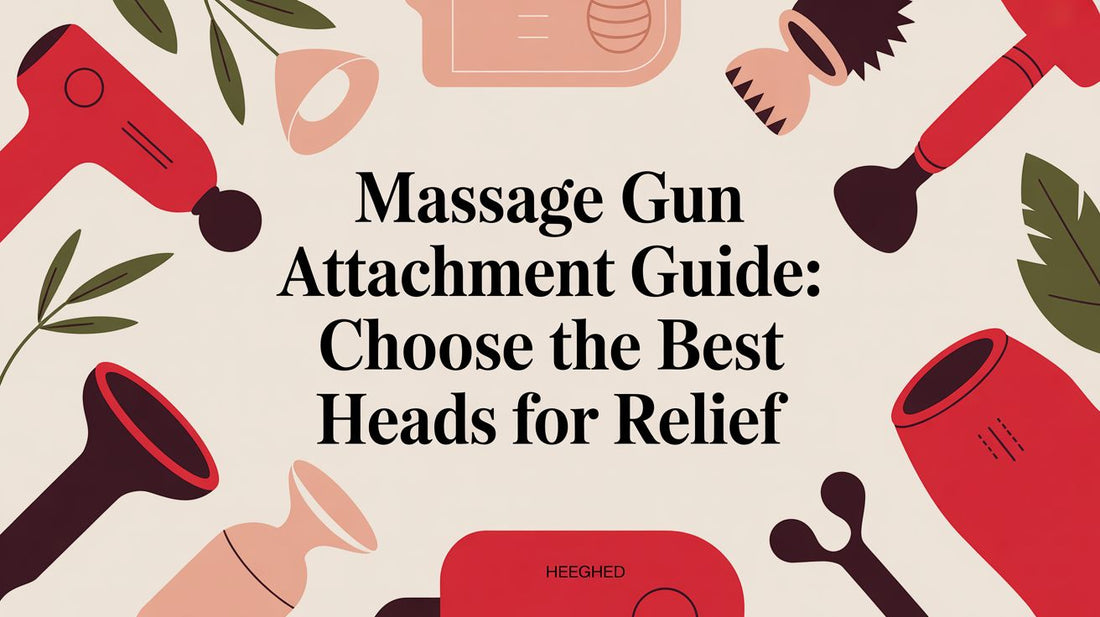
Ever opened your massage gun case and felt overwhelmed by all the different heads? If you've been guessing which attachment to use, you're not alone. This complete massage gun attachment guide is here to clear up the confusion and help you get the most out of every session.
Choosing the right head isn't just a minor detail—it's the secret to unlocking targeted relief and making your recovery truly effective. Using the right tool for the job helps support circulation and reduce muscle soreness after a tough workout or a long day at your desk.
Matching the Right Attachment to Your Muscles
Think of each massage gun head as a specialized tool. Using the wrong one can feel ineffective or even uncomfortable. But when you snap on the right one, you can target specific muscle groups with precision. This is key to understanding what a massage gun does to promote recovery.
Whether you're warming up, recovering from a long day, or soothing sore muscles, this guide will show you exactly how to get the results you want. Let's dive in.
Why Is Everyone Talking About Percussive Therapy?
The buzz around massage guns is more than a passing trend. The market has grown significantly, driven by new technology and a rising demand for at-home wellness solutions that deliver real results.
In fact, the global massage guns market was valued at USD 1.5 billion as of 2025 and is projected to climb to USD 3.7 billion by 2035. This growth comes from smarter features and the widespread adoption of percussive therapy in both home fitness routines and professional sports.
To help you get started, this infographic breaks down the main uses for the three most common attachments.
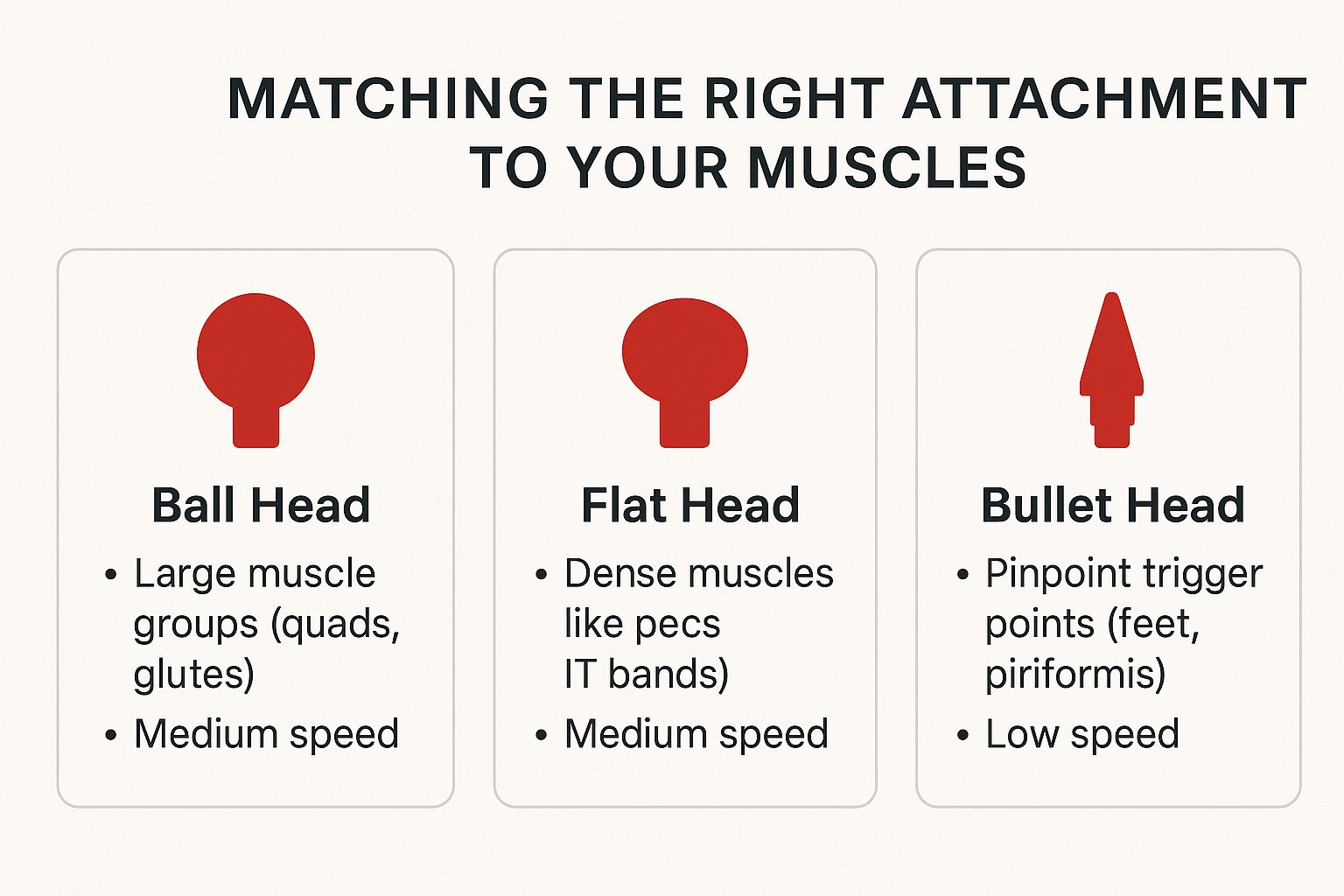
This visual guide is a great starting point, showing you how to match the head to the muscle group for the best relief. It helps you decide whether you need to target large areas or zero in on tight trigger points.
Getting Started with Your Attachments
Next, we’ll dive into the most common attachments you’ll find with quality models like the Cryotex massage gun. Our goal is to give you the confidence to customize every massage for your specific needs.
"I used to just stick with the round ball for everything. Once I learned how to use the fork head on my calves, it was a total game-changer after my runs." - Sarah L., Chicago, IL
Understanding the basics is all it takes to move beyond guessing. Soon, you’ll be targeting your muscle needs with precision, which is the first step toward more effective recovery.
To make things even simpler, here's a quick cheat sheet for the most popular attachments.
Quick Guide to Common Massage Gun Attachments
| Attachment Name | Best For | Target Muscle Groups |
|---|---|---|
| Ball Head | General, all-over use; great for beginners | Large muscle groups like glutes, quads, and hamstrings |
| Fork Head | Targeting muscles around the spine and joints | Neck, spine, calves, and Achilles tendon |
| Bullet Head | Deep tissue and trigger point therapy | Specific knots in shoulders, back, and feet (plantar fasciitis) |
| Flat Head | Dense, large muscle groups; less intense than the ball | IT bands, pecs, and glutes |
Keep this table handy as you start experimenting. It’s the perfect reference for finding the right tool for the job, every time.
Your Go-To Attachments for Everyday Relief
Let's start with the two attachments you'll probably reach for most often: the large Ball head and the versatile Flat head. Think of these as the workhorses of your massage gun kit, perfect for tackling general muscle soreness and promoting daily relaxation.
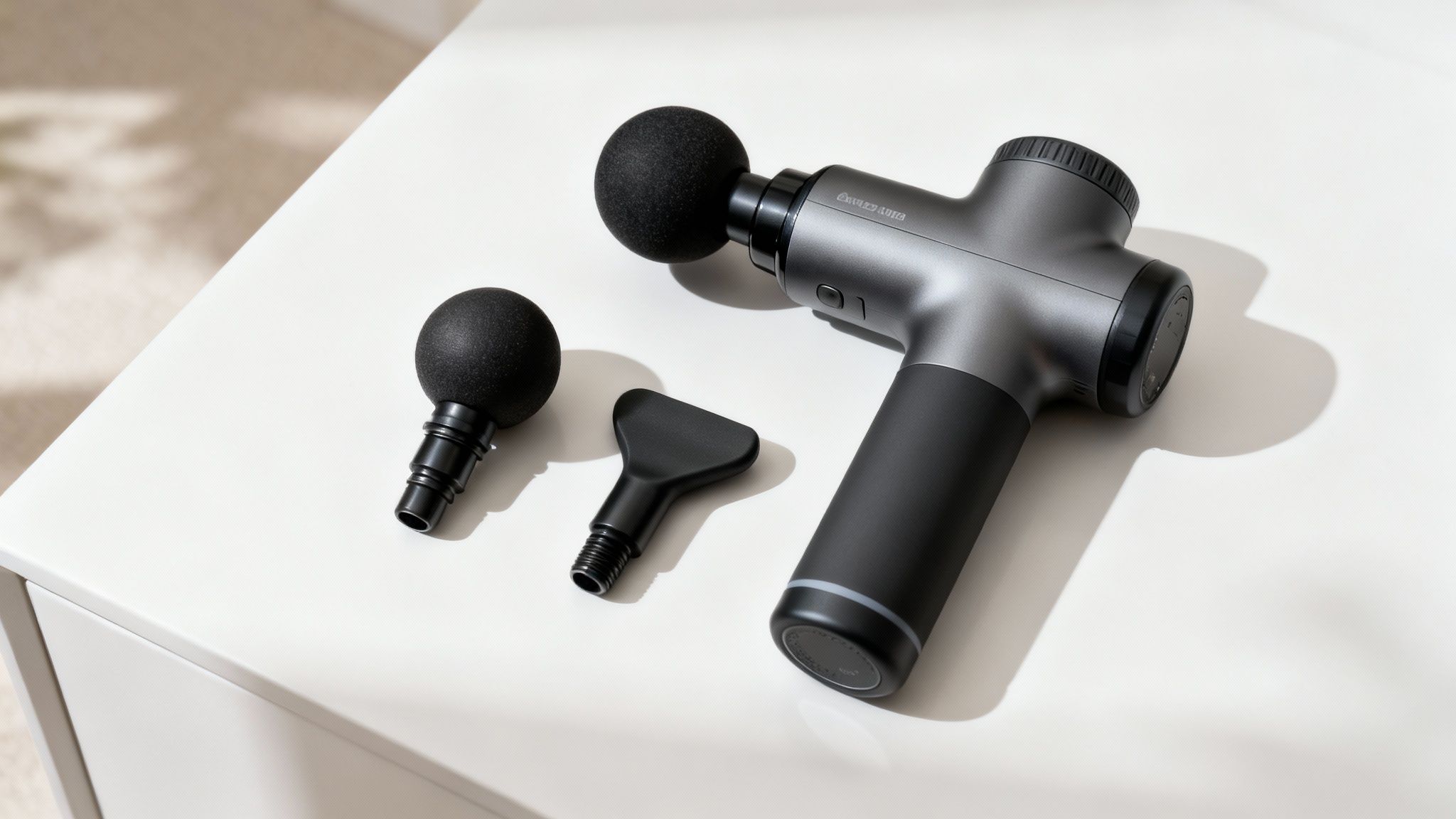
The Ball head is your universal starting point. Its round shape creates a gentler, more widespread percussion that’s ideal for large muscle groups like your glutes, hamstrings, and quads. This makes it a fantastic choice for a pre-workout warm-up or for anyone just getting started with percussive therapy.
The All-Purpose Ball Head
Consider the Ball head your go-to for covering a lot of ground comfortably. After a long run, glide it over your quads to help reduce that heavy, tired feeling. Or, if you’ve spent hours at a desk, a few minutes on your glutes can make a world of difference.
Its forgiving design is less intense than more targeted heads, which is why it's a staple in nearly every massage gun set.
"I always start my clients with the ball attachment. It's gentle enough to warm up the tissue without being overwhelming, which builds confidence and makes the whole session more effective." - Certified Personal Trainer
This approach preps the muscles for deeper work if needed, ensuring the session is comfortable and productive. It’s a core part of understanding the real benefits of using a massage gun day-to-day.
The Versatile Flat Head
Next up is the Flat head, a personal favorite for dense muscle groups that need consistent, even pressure. Its smooth, wide surface spreads the force out, letting you work deeper into the muscle without the sharp intensity of other attachments.
This makes it perfect for areas like the pecs after chest day or the calves after a long day on your feet. The flat surface also slides easily over clothing, making it convenient for quick relief.
- For Office Professionals: Use the Flat head on your lower back to help soothe tension from sitting all day.
- For Athletes: It’s excellent for working on dense spots like the pecs, glutes, or calves that hold a lot of tension.
- For General Wellness: Try it on your hamstrings to address tightness before you start stretching.
The popularity of these tools reflects a huge shift toward proactive self-care. In fact, the U.S. percussion massage gun market was valued at USD 130.7 million in 2025 and is expected to hit USD 201.2 million by 2035. This trend shows just how many people are investing in their own muscle recovery.
High-quality models like the Cryotex often feature heads made from high-density foam or cushioned silicone for added comfort. This small detail allows you to relax into the session without any harsh impact. Mastering just these two attachments will cover about 80% of your everyday recovery needs.
Targeting Deep Knots with Precision Tools
When you have a stubborn knot that just won't budge, it’s time to bring in the specialists. This is where the Bullet and Fork heads come in. Think of them as precision instruments, designed to dig deeper than broader attachments to help release persistent trigger points.
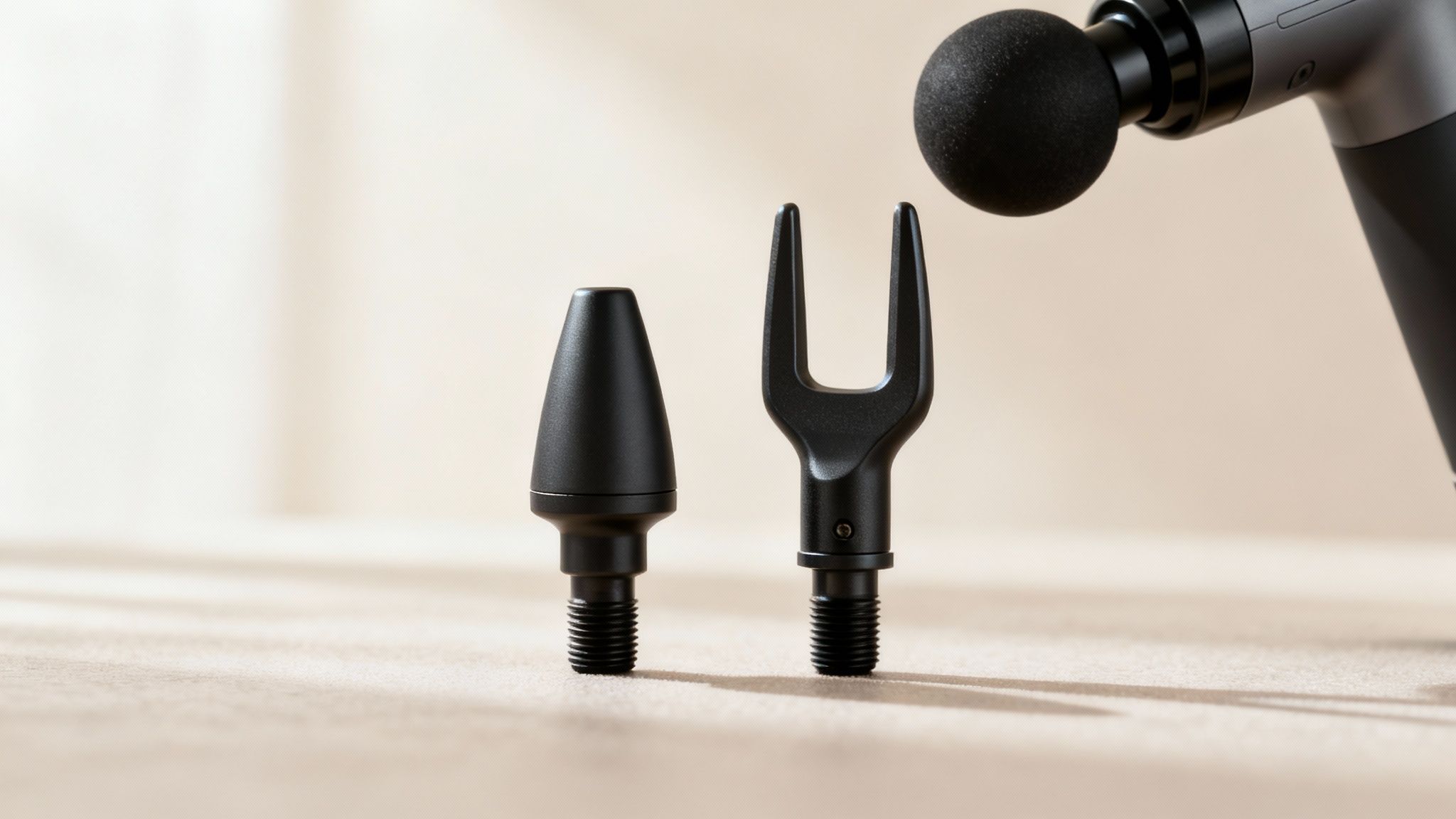
These attachments require more finesse, but learning how to use them properly can unlock a new level of relief. Any good massage gun guide would be incomplete without them.
Zeroing In with the Bullet Head
The Bullet attachment is all about pinpoint accuracy. Its small, tapered tip lets you apply concentrated pressure directly onto a trigger point, helping dissolve deep-seated tension in specific areas.
It's fantastic for hard-to-reach spots. Use it on the arch of your foot after a long day or for getting into the piriformis muscle deep in the glutes, which can often cause tightness.
The trick with the Bullet head is to start with light pressure and let the percussion do the work. Keep the attachment moving in small circles over the knot for no more than 15-30 seconds at a time. Avoid pressing hard or holding it in one spot for too long.
Navigating Sensitive Areas with the Fork Head
The Fork head is a game-changer for working around sensitive areas you should never massage directly, like your spine. Its main job is to target the muscles running alongside the spinal column without putting risky pressure on the vertebrae.
This makes it the go-to for the paraspinal muscles, which get notoriously tight from hunching over a desk. Glide the Fork head up and down your back, letting your spine rest safely between the two prongs.
But the Fork head is more versatile than you might think. It's also effective for other tricky spots:
- Achilles Tendon: Work the muscles around the tendon—never directly on it—to soothe tightness in your lower calf.
- Upper Traps: Carefully trace the thick muscle running from your neck to your shoulders to help melt away tension.
- Ankles and Calves: The two prongs are great for bracketing the calf muscle for a thorough, targeted massage.
If you want to see how certain models are built for this kind of detailed work, check out our deep dive on why Cryotex is the best massage gun for deep muscle recovery in 2025.
Here’s a crucial safety tip: always start on the lowest speed setting with these precision heads. A gentle approach is safer and more effective. Most importantly, listen to your body. If you feel any sharp pain, stop immediately.
Using Specialty Heads for Enhanced Recovery
Beyond the standard attachments, many massage guns now come with specialty heads for enhanced relief. These are designed for specific jobs, from working on sensitive spots to bringing therapeutic temperatures into your routine.
This is where a good massage gun attachment guide goes beyond the basics and dives into advanced, personalized recovery.
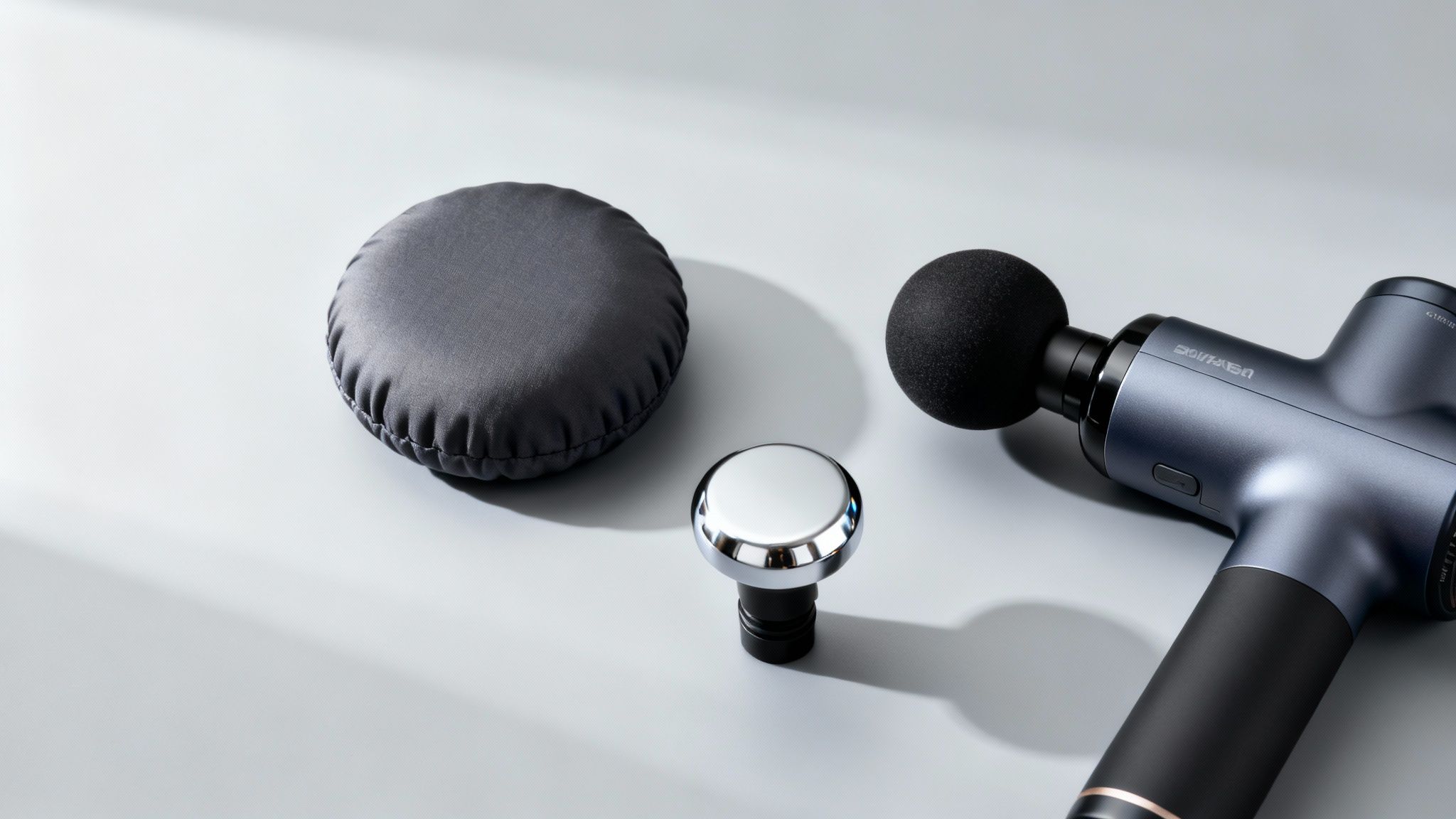
These tools can transform your device from a simple massager into a full-on recovery system you can use right in your living room.
The Gentle Touch of the Cushioned Head
Ever tried to use a massage gun on your shins or collarbone, only to find it too intense? That's where the Cushioned head comes in. Also called an Air-Filled or Dampener head, it's a game-changer for sensitive spots.
This attachment has a soft, forgiving surface that absorbs much of the direct impact. This design makes it perfect for gliding over or near bony areas where other heads would feel jarring.
- For Sensitive Areas: Think shins, the tops of your feet, or forearms.
- For Bony Joints: It works beautifully around the shoulders, knees, and elbows without causing rattling.
- For Acute Soreness: When a muscle is extra tender, this head provides gentle relief without being too aggressive.
It's also a fantastic starting point for older adults or anyone new to percussive therapy who needs a gentler touch.
Adding Temperature for Deeper Relief
The most exciting evolution in massage gun tech is the arrival of therapeutic attachments—specifically, heated and cooled heads. These bring the proven benefits of temperature therapy into your massage, taking your recovery to another level.
A heated head is incredible for warming up stiff muscles. The gentle warmth helps boost circulation, making muscle tissue more pliable and ready for massage. Imagine using it on your lower back on a cold morning to melt away stiffness.
On the flip side, a cold head is your best friend after a grueling workout. The cooling sensation helps dial down inflammation and soothes immediate soreness, much like an ice pack but with the added bonus of gentle percussion.
This trend isn't just a gimmick. The global hot and cold massage gun heads market hit $9.8 million in 2025 and is set to keep growing. Why? People are realizing how effective and convenient at-home, targeted therapy can be. You can dive deeper into this growing market on MarketReportAnalytics.com.
Innovative brands are integrating these heads seamlessly, with some Cryotex bundles leading the way. Having these options means you can give your body exactly what it needs, whether that’s gentle relief, deep warmth, or cooling comfort.
How to Use and Clean Your Attachments Safely
Knowing which attachment to use is only half the battle. This part of our massage gun attachment guide covers the practical side of things, making sure every session is safe and effective.
First, let's talk about "no-go zones." A massage gun is for muscle, not bone. Always steer clear of bony spots like your spine, shins, kneecaps, or elbows. It won't feel good and could be harmful.
You also need to avoid major arteries. That means no massaging the side of your neck, your armpits, or the front of your throat. Your head is off-limits, too. The golden rule? Stick to the fleshy parts of your muscles.
Key Tips for Safe and Effective Use
Building confidence with your massage gun is all about following a few simple principles. Always start on the lowest speed setting. This lets your muscles warm up and helps you gauge how they feel. Remember—more power isn't always better.
It's also important to avoid using the device on a fresh injury, like a sprain or pulled muscle. If an area is swollen or has broken skin, let it heal first. Percussive therapy is for supporting recovery from muscle soreness, not for addressing open wounds.
A few more things to keep in mind:
- Keep It Moving: Don't press the massage gun into one spot and hold it there. Glide it slowly over the muscle, spending no more than 15-30 seconds on any single area.
- Listen to Your Body: If you feel sharp pain, tingling, or numbness, stop right away. There's a difference between the "good hurt" of muscle release and actual pain.
- Stay Relaxed: Tensing up is the opposite of what you want. Take a deep breath, relax the muscle you're working on, and let the massage gun do its thing.
For more ideas on weaving this into your routine, check out our post on the benefits of using a massage gun.
Keeping Your Attachments Clean
Good hygiene is important, especially if you share your device. A quick wipe-down after each use is all it takes to keep your attachments in great shape.
"I just keep a pack of alcohol-free antibacterial wipes next to my massage gun. After my post-run session, I wipe down the head I used. It takes ten seconds and keeps everything feeling fresh." - Mark T., New York, NY
Use a slightly damp cloth or an alcohol-free antibacterial wipe to clean the surface, getting rid of any sweat or oils. Make sure the head is completely dry before putting it away. This simple step prevents bacteria from building up.
Proper care turns your massage gun into a wellness partner you can count on. Find the perfect tools for your routine by exploring our Cryotex Holiday Bundle.
Your Top Massage Gun Questions, Answered
We've heard just about every question you can imagine when it comes to massage guns. To make things simple, we've pulled together the most common ones right here.
Which Massage Gun Attachment Is Best for Lower Back Pain?
For general ache across the lower back, the Flat head is your best friend. Its wide surface provides a soothing, broad-pressure massage without feeling too intense. It's perfect for warming up the area.
If you’re trying to get to the tight muscles running alongside your spine, switch to the Fork head. Its design lets you work on those muscles directly while completely avoiding the sensitive vertebrae.
A Quick Word of Caution: Always start on the lowest speed. If you feel any sharp or shooting pain, stop immediately. For any serious or persistent back issues, it's always smart to check with a doctor first.
How Do I Know Which Attachment to Use?
Here’s a simple rule of thumb: match the size of the head to the size of the muscle.
- Large Attachments (Ball or Flat): These are built for big muscle groups like your glutes, quads, and hamstrings. They cover more ground and deliver less intense, distributed pressure.
- Small Attachments (Bullet): Save this one for precision work. It’s perfect for digging into stubborn knots in your shoulders or the arches of your feet.
- Specialty Attachments (Fork or Cushioned): The Fork is for tricky spots like around the spine. The Cushioned head is your go-to for bony areas or anywhere you need a softer touch.
Ultimately, the best way to learn is to listen to your body. Start slow, on the lowest setting, and see what feels right.
Can I Use a Massage Gun Attachment on My Neck?
You must be incredibly careful here. Never use a massage gun on the front or sides of your neck. This area contains major arteries and nerves, and it's not worth the risk.
The Fork attachment can be used very gently on the lowest speed to hit the thick trapezius muscles where your neck meets your shoulders. Stay on the muscle and keep it far away from your cervical spine. If you have any history of neck pain or injury, please talk to your doctor first.
How Often Should I Clean My Massage Gun Heads?
It’s best to give them a quick wipe-down after every use. It only takes a second and is a great habit, especially if you're sweating or sharing the device with someone else.
An alcohol-free antibacterial wipe or a cloth with a bit of soap and water does the trick. This stops oils and bacteria from building up and keeps your attachments hygienic.
At BestMassageGun.com, our entire focus is on helping you find the right tools to feel your absolute best.